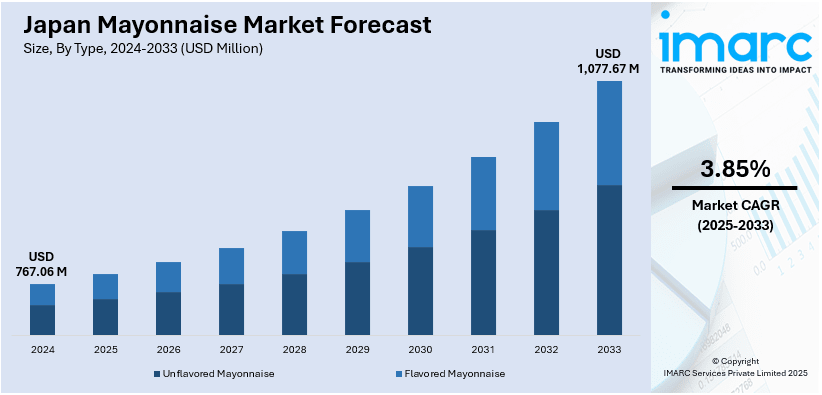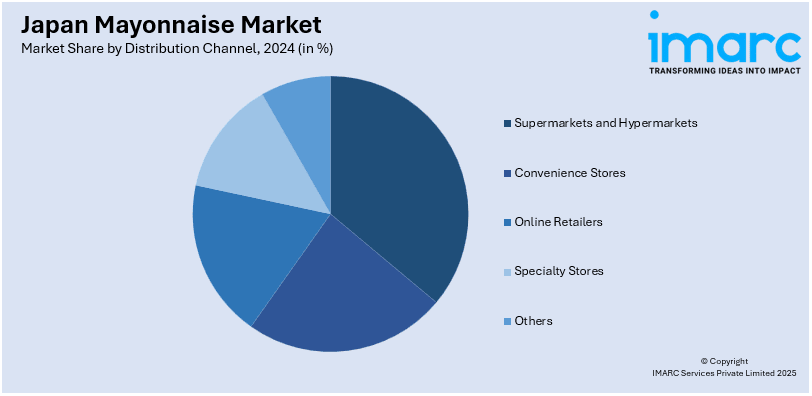
Japan Mayonnaise Market Size, Share, Trends and Forecast by Type, Distribution Channel, End Use, and Region, 2025-2033
Japan Mayonnaise Market Overview:
The Japan mayonnaise market size reached USD 767.06 Million in 2024. Looking forward, IMARC Group expects the market to reach USD 1,077.67 Million by 2033, exhibiting a growth rate (CAGR) of 3.85% during 2025-2033. The market is driven by strong domestic consumption, culinary integration in traditional and Western dishes, and the popularity of iconic brands like Kewpie. Moreover, health-conscious product innovations, premium offerings, and expanding foodservice demand, along with Japan’s appreciation for umami-rich flavors and unique condiment preferences in everyday meals further fuel growth.
|
Report Attribute
|
Key Statistics
|
|---|---|
|
Base Year
|
2024
|
|
Forecast Years
|
2025-2033
|
|
Historical Years
|
2019-2024
|
| Market Size in 2024 | USD 767.06 Million |
| Market Forecast in 2033 | USD 1,077.67 Million |
| Market Growth Rate 2025-2033 | 3.85% |
Japan Mayonnaise Market Trends:
Premiumization and Unique Flavor Innovations
One of the significant trends influencing the Japan mayonnaise market outlook is the increasing popularity of premium and specially flavored mayonnaise products. People are more interested in handmade and high-quality ingredients, compelling companies to provide premium types produced using free-range eggs, organic oil, and natural spices. Japan's robust appreciation of umami tastes has resulted in the development of mayonnaise with ingredients such as wasabi, yuzu, soy sauce, and spicy cod roe (mentaiko), appealing to both classic and contemporary tastes. Such distinctive taste profiles are characteristic of Japan's culinary innovation and are frequently applied to sushi, okonomiyaki, takoyaki, and fusion foods. High-end packaging and limited releases also appeal to consumers who desire novelty and exclusivity. This is supported by a very loyal customer base that is willing to pay a premium for quality and innovation. Consequently, product differentiation and flavor experimentation remain fundamental strategies for mayonnaise brands seeking to stay relevant and grow market share. For example, in 2024, the launch of ‘Nomu Mayo’ by Lawson in Japan, which is a mayo flavored chilled drink, is another example of flavor and texture experimentation.

Rising Health-Conscious Consumption and Low-Fat Options
Health consciousness is having a strong impact on the Japan mayonnaise market share, with demand for low-fat, low-calorie, and functional types on the rise. According to the IMARC Group, the Japan health and wellness market size reached USD 207.28 Billion in 2024 and is further expected to reach USD 287.50 Billion by 2033, exhibiting a growth rate (CAGR) of 3.51% during 2025-2033. As cholesterol, calorie consumption, and overall health concerns grow, consumers are looking for healthier condiment options that are not at the expense of taste. Hence, manufacturers are responding by launching mayonnaise products with lower oil content, plant-based ingredients, or fortified with functional ingredients like dietary fiber and omega-3 fatty acids. Eggless and vegan versions are also increasingly popular, particularly with younger consumers and those with dietary needs. Products such as Kewpie have introduced lighter, health-oriented versions of their traditional mayonnaise, targeting mainstream as well as niche consumers. Clear labeling, nutritional openness, and clean ingredients are becoming increasingly important factors in determining buying decisions. This is a part of larger lifestyle changes in Japan, where consumers are embracing balanced diets while still indulging in their favorite traditional and Western-influenced foods with adapted condiments.
Strong Integration in Foodservice and Everyday Cuisine
Mayonnaise is highly ingrained in Japanese food culture, so its use in home-prepared foods and foodservice items is a central market trend. It is also used extensively as an ingredient, not only as a condiment, for preparation of foods such as potato salad, tamagoyaki (Japanese omelet), sushi rolls, and savory pancakes like okonomiyaki. The convenience of using mayonnaise has led it to become a standard item in home kitchens as well as on restaurant menus. The foodservice industry—especially bento services, casual dining, and convenience store meals—is highly dependent on mayonnaise for flavor and texture enhancement. Well-known chains and ready-to-eat food outlets frequently include mayonnaise-based products, driving steady, high-volume demand. Moreover, consumers' willingness to adopt global foods has resulted in expanded use of mayonnaise in sandwiches, burgers, and fusion foods. This rooted culinary usage, coupled with continuous expansion in foodservice infrastructure and product innovation, guarantees a steady trajectory for Japan mayonnaise market growth amidst its dynamic food culture.
Japan Mayonnaise Market Segmentation:
IMARC Group provides an analysis of the key trends in each segment of the market, along with forecasts at the regional level for 2025-2033. Our report has categorized the market based on type, distribution channel, and end use.
Type Insights:
- Unflavored Mayonnaise
- Flavored Mayonnaise
The report has provided a detailed breakup and analysis of the market based on the type. This includes unflavored mayonnaise and flavored mayonnaise.
Distribution Channel Insights:

- Supermarkets and Hypermarkets
- Convenience Stores
- Online Retailers
- Specialty Stores
- Others
The report has provided a detailed breakup and analysis of the market based on the distribution channel. This includes supermarkets and hypermarkets, convenience stores, online retailers, specialty stores, and others.
End Use Insights:
- Institutional
- Retail
The report has provided a detailed breakup and analysis of the market based on the end use. This includes institutional and retail.
Regional Insights:
- Kanto Region
- Kansai/Kinki Region
- Central /Chubu Region
- Kyushu-Okinawa Region
- Tohoku Region
- Chugoku Region
- Hokkaido Region
- Shikoku Region
The report has also provided a comprehensive analysis of all the major regional markets, which include Kanto Region, Kansai/Kinki Region, Central /Chubu Region, Kyushu-Okinawa Region, Tohoku Region, Chugoku Region, Hokkaido Region, and Shikoku Region.
Competitive Landscape:
The market research report has also provided a comprehensive analysis of the competitive landscape. Competitive analysis such as market structure, key player positioning, top winning strategies, competitive dashboard, and company evaluation quadrant has been covered in the report. Also, detailed profiles of all major companies have been provided.
Japan Mayonnaise Market News:
- In October 2024, Kewpie Corporation announced that incorporating mayonnaise or emulsified dressings enhances the ease of consuming foods like vegetables, which older adults often struggle to eat. This discovery was made through collaborative research with Professor Yukie Yanagisawa and colleagues from Wayo Women's University. The findings of this study were revealed during the 35th General Meeting of the Japanese Society for Mastication Science and Health Promotion, which took place on September 14 and 15, 2024.
- In January 2024, AJINOMOTO provided product samples such as Mayonnaise Aji-mayo® and AJINOMOTO® Oyster Sauce to the Japan Heart Children’s Medical Center located in Oudong City. AJINOMOTO (CAMBODIA) previously partnered with Japan Heart Children’s Medical Center to donate their Nutrition Basics Booklets, and they anticipate future collaboration.
Japan Mayonnaise Market Report Coverage:
| Report Features | Details |
|---|---|
| Base Year of the Analysis | 2024 |
| Historical Period | 2019-2024 |
| Forecast Period | 2025-2033 |
| Units | Million USD |
| Scope of the Report |
Exploration of Historical Trends and Market Outlook, Industry Catalysts and Challenges, Segment-Wise Historical and Future Market Assessment:
|
| Types Covered | Unflavored Mayonnaise, Flavored Mayonnaise |
| Distribution Channels Covered | Supermarkets And Hypermarkets, Convenience Stores, Online Retailers, Specialty Stores, Others |
| End Uses Covered | Institutional, Retail |
| Regions Covered | Kanto Region, Kansai/Kinki Region, Central /Chubu Region, Kyushu-Okinawa Region, Tohoku Region, Chugoku Region, Hokkaido Region, Shikoku Region |
| Customization Scope | 10% Free Customization |
| Post-Sale Analyst Support | 10-12 Weeks |
| Delivery Format | PDF and Excel through Email (We can also provide the editable version of the report in PPT/Word format on special request) |
Key Questions Answered in This Report:
- How has the Japan mayonnaise market performed so far and how will it perform in the coming years?
- What is the breakup of the Japan mayonnaise market on the basis of type?
- What is the breakup of the Japan mayonnaise market on the basis of distribution channel?
- What is the breakup of the Japan mayonnaise market on the basis of end use?
- What is the breakup of the Japan mayonnaise market on the basis of region?
- What are the various stages in the value chain of the Japan mayonnaise market?
- What are the key driving factors and challenges in the Japan mayonnaise?
- What is the structure of the Japan mayonnaise market and who are the key players?
- What is the degree of competition in the Japan mayonnaise market?
Key Benefits for Stakeholders:
- IMARC’s industry report offers a comprehensive quantitative analysis of various market segments, historical and current market trends, market forecasts, and dynamics of the Japan mayonnaise market from 2019-2033.
- The research report provides the latest information on the market drivers, challenges, and opportunities in the Japan mayonnaise market.
- Porter's five forces analysis assist stakeholders in assessing the impact of new entrants, competitive rivalry, supplier power, buyer power, and the threat of substitution. It helps stakeholders to analyze the level of competition within the Japan mayonnaise industry and its attractiveness.
- Competitive landscape allows stakeholders to understand their competitive environment and provides an insight into the current positions of key players in the market.
Need more help?
- Speak to our experienced analysts for insights on the current market scenarios.
- Include additional segments and countries to customize the report as per your requirement.
- Gain an unparalleled competitive advantage in your domain by understanding how to utilize the report and positively impacting your operations and revenue.
- For further assistance, please connect with our analysts.
 Request Customization
Request Customization
 Speak to an Analyst
Speak to an Analyst
 Request Brochure
Request Brochure
 Inquire Before Buying
Inquire Before Buying




.webp)




.webp)












